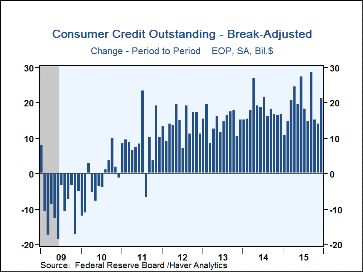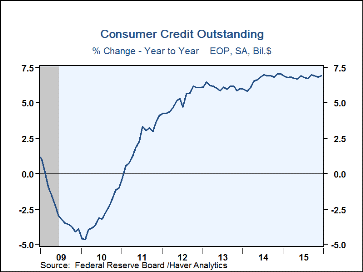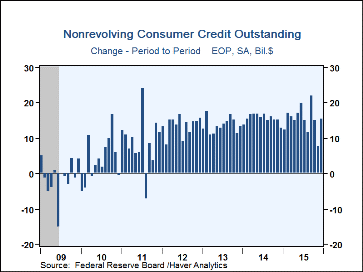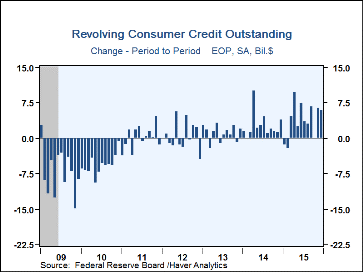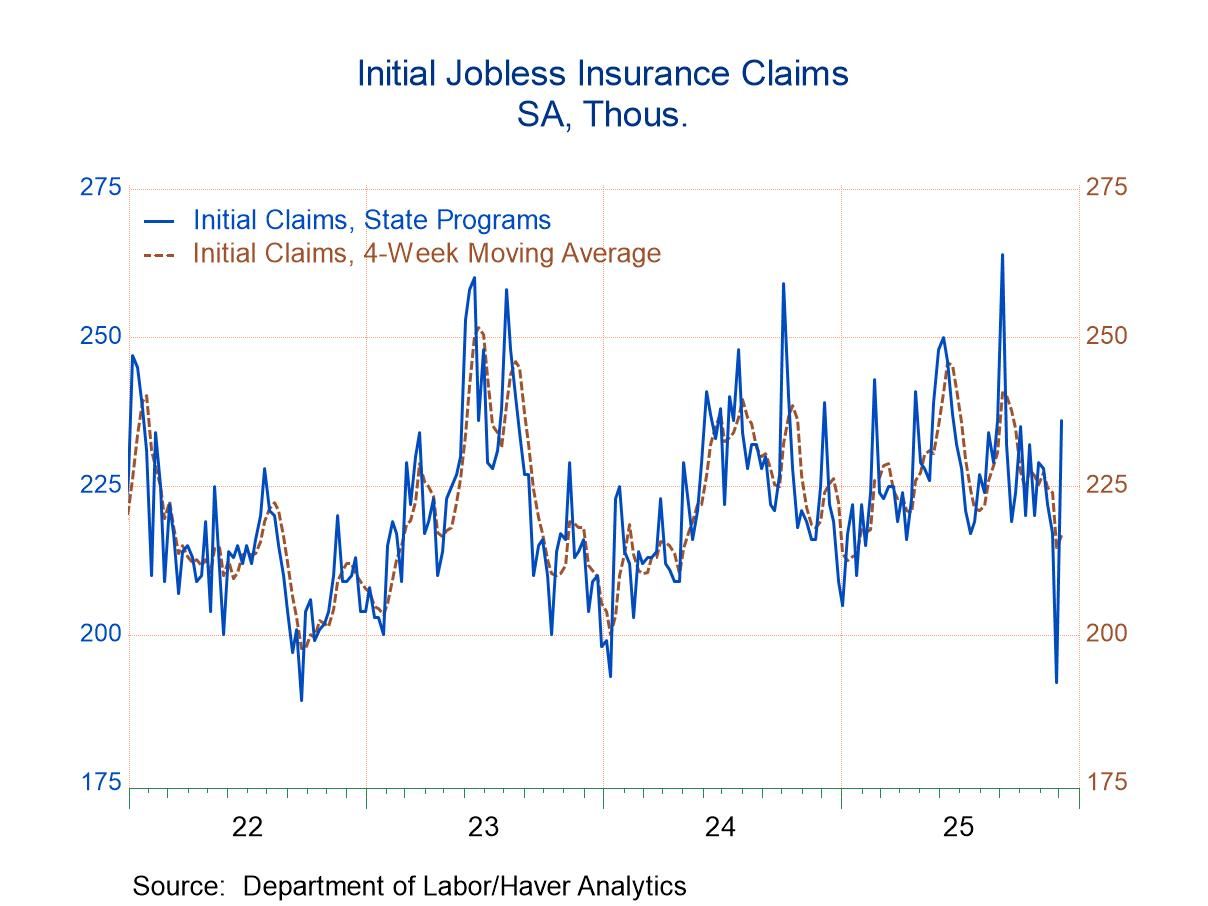 Global| Feb 05 2016
Global| Feb 05 2016U.S. Consumer Credit Usage Ramps Up in December; Remains Steady in 2015
by:Tom Moeller
|in:Economy in Brief
Summary
Consumer credit outstanding increased $21.3 billion during December following an unrevised $14.0 billion November gain. For all of last year, consumer credit balances grew 6.9% to $3.55 trillion, the same growth as in 2014. Action [...]
Consumer credit outstanding increased $21.3 billion during December following an unrevised $14.0 billion November gain. For all of last year, consumer credit balances grew 6.9% to $3.55 trillion, the same growth as in 2014. Action Economics Forecast Survey participants looked for a $15.8 billion December increase. During the last ten years, there has been a 46% correlation between the y/y growth in consumer credit and y/y growth in personal consumption expenditures.
Nonrevolving credit borrowing grew by $15.4 billion, a 7.6% y/y increase. For all of last year, these balances totaled $2.61 trillion. Federal government loans (36% of that total) increased 12.5% y/y. Finance company balances (24% of the total) edged 0.3% higher. Borrowing at depository institutions (25% of the total) increased 7.4% y/y, and borrowing at credit unions (11% of the total) advanced 14.2% y/y. Nonprofit & educational institution loans (2% of the total) declined 12.0% y/y, and nonfinancial business loans (1% of the total) remained unchanged y/y.
Revolving consumer credit in December grew $5.8 billion, up 5.1% y/y. For 2015, these balances totaled $0.94 trillion. Credit card balances at depository institutions (84% of this total) increased 6.9% y/y. Finance company holdings (6% of the total) fell 4.4% y/y, while borrowing from credit unions (5% of the total) advanced 5.7% y/y. Nonfinancial business credit (2% of the total) fell 3.3% y/y, and securitized credit card balances (3% of the total) declined 14.7% y/y.
Student loans outstanding rose 6.8% y/y to $1.32 trillion. Motor vehicle loans increased 8.5% y/y to $1.04 trillion.
These Federal Reserve Board figures are break-adjusted and calculated by Haver Analytics. There is a break in the credit outstanding data from November 2010 to December 2010 due to the Fed's benchmarking process. Benchmark estimates are based on the Census of Finance Companies (CFC) and the Survey of Finance Companies (SFC) conducted in 2010 and 2011, respectively.
The consumer credit data are available in Haver's USECON database. The Action Economics figures are contained in the AS1REPNA database.
Labor Market Strength Supports U.S. Outlook from the Federal Reserve Bank of Dallas can be found here.
| Consumer Credit Outstanding (M/M Chg, SA) | Dec | Nov | Oct | Y/Y | 2015 | 2014 | 2013 |
|---|---|---|---|---|---|---|---|
| Total | $21.3 bil. | $14.0 bil. | $15.1 bil. | 6.9% | 6.9% | 7.0% | 6.0% |
| Revolving | 5.8 | 6.4 | 0.0 | 5.1 | 5.1 | 3.7 | 1.4 |
| Nonrevolving | 15.4 | 7.7 | 15.1 | 7.6 | 7.6 | 8.3 | 7.9 |
Tom Moeller
AuthorMore in Author Profile »Prior to joining Haver Analytics in 2000, Mr. Moeller worked as the Economist at Chancellor Capital Management from 1985 to 1999. There, he developed comprehensive economic forecasts and interpreted economic data for equity and fixed income portfolio managers. Also at Chancellor, Mr. Moeller worked as an equity analyst and was responsible for researching and rating companies in the economically sensitive automobile and housing industries for investment in Chancellor’s equity portfolio. Prior to joining Chancellor, Mr. Moeller was an Economist at Citibank from 1979 to 1984. He also analyzed pricing behavior in the metals industry for the Council on Wage and Price Stability in Washington, D.C. In 1999, Mr. Moeller received the award for most accurate forecast from the Forecasters' Club of New York. From 1990 to 1992 he was President of the New York Association for Business Economists. Mr. Moeller earned an M.B.A. in Finance from Fordham University, where he graduated in 1987. He holds a Bachelor of Arts in Economics from George Washington University.


